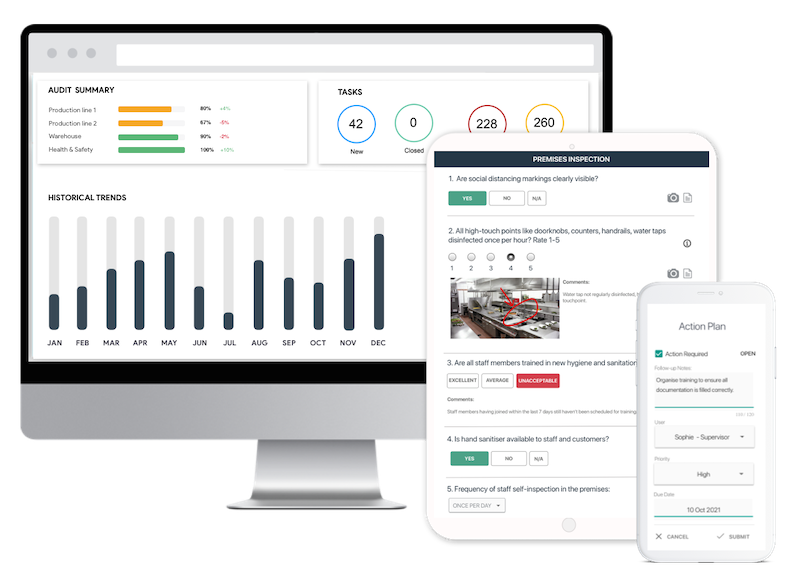- Library ›
- Manufacturing ›
- Process Safety Management Audit
Process Safety Management Audit
Employee Participation – 1910.119(c)(1)
Employee Participation – 1910.119(c)(2)
Employee Participation – 1910.119(c)(3)
Hazard Information Collection – 1910.119(d)(1)
Technology Of The Process Information Collection – 1910.119(d)(2)(i)(A)
Technology Of The Process Information Collection – 1910.119(d)(2)(i)(B-D)
Technology Of The Process Information Collection – 1910.119(d)(2)(i)(E)
Equipment Of The Process Information Collection – 1910.119(d)(3)(i)(A-H)
Process Hazard Analysis – 1910.119(e)(1)
Process Hazard Analysis – 1910.119(e)(2)(i-vii)
Process Hazard Analysis – 1910.119(e)(3)(i-vii)
Process Hazard Analysis – 1910.119(e)(4)
Process Hazard Analysis – 1910.119(e)(5)
Process Hazard Analysis – 1910.119(e)(6)
Process Hazard Analysis – 1910.119(e)(7)
Operating Procedures – 1910.119(f)(1)
Employee Training – 1910.119(g)(1)
Employee Training – 1910.119(g)(2)
Employee Training – 1910.119(g)(3)
Contractor Management – 1910.119(h)(2)(i)
Contractor Management – 1910.119(h)(2)(ii)
Contractor Management – 1910.119(h)(2)(iii)
Contractor Management – 1910.119(h)(2)(iv)
Contractor Management – 1910.119(h)(2)(v)
Contractor Management – 1910.119(h)(2)(vi)
Contractor Management – 1910.119(h)(3)(i-iv)
Pre-Startup Safety Review – 1910.119(i)
Mechanical Integrity Of Process Equipment – 1910.119(j)(2)
Mechanical Integrity Of Process Equipment – 1910.119(j)(3)
1. Does the employer have documentation of training that each employee involved in the maintaining of the ongoing integrity of covered process equipment has been informed of the hazards of the process and the procedures applicable to the employee’s job task and how to perform the job task in a safe manner?
|
Photo
Comment
|
Mechanical Integrity Of Process Equipment – 1910.119(j)(4)
1. Does the employer have documentation that the employer has performed inspections and tests on the covered process equipment following generally accepted engineering practices or manufacturer’s recommendations on a frequency that is according to generally accepted engineering practices, manufacturer’s recommendations or more frequently if determined by prior experience? The documentation should include the date, name of the person performing the inspection or test, description of the inspection or test, and results of the inspection or test.
|
Photo
Comment
|
Mechanical Integrity Of Process Equipment – 1910.119(j)(5)
Mechanical Integrity Of Process Equipment – 1910.119(j)(6)
1. Has the employer assured that fabricated equipment is suitable for the process application (applicable codes), has been inspected and checked for proper installation consistent with design specification and manufacturer’s recommendations, and all maintenance materials and spare parts are also suitable for the process application?
|
Photo
Comment
|
Hot Work – 1910.119(k)
Management Of Change – 1910.119(l)(1-2)
Management Of Change – 1910.119(l)(3)
Management Of Change – 1910.119(l)(4-5)
Incident Investigation – 1910.119(m)(1)
Incident Investigation – 1910.119(m)(2)
Incident Investigation – 1910.119(m)(3)
Incident Investigation – 1910.119(m)(4)
Incident Investigation – 1910.119(m)(5)
Incident Investigation – 1910.119(m)(6)
Incident Investigation – 1910.119(m)(7)
Emergency Planning And Response – 1910.119(n)
Compliance Audit – 1910.119(o)(1-3)
Compliance Audit – 1910.119(o)(4)
Compliance Audit – 1910.119(o)(5)
Trade Secrets – 1910.119(p)
Is this sample what you are looking for?
Sign up to use & customise this template, or create your own custom checklist:
Checklist by GoAudits.com – Please note that this checklist is intended as an example. We do not guarantee compliance with the laws applicable to your territory or industry. You should seek professional advice to determine how this checklist should be adapted to your workplace or jurisdiction.
Easy inspection app for your digital checklists
- Conduct inspections anytime, anywhere - even offline
- Capture photos as proof of compliance or areas needing attention
- Instantly generate and share detailed reports after the inspections
- Assign & track follow-up tasks, view historical trends on a centralized dashboard

